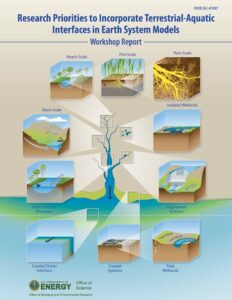Research Priorities to Incorporate Terrestrial-Aquatic Interfaces in Earth System Models Workshop Report
- Electronic Publication: February 2017
- Print Publication: June 2017
- Workshop Dates: September 7-9, 2016
- Report Download: Fast-download PDF
The U.S. Department of Energy’s (DOE) Office of Biological and Environmental Research (BER) held the Research Priorities to Incorporate Terrestrial-Aquatic Interfaces in Earth System Models Workshop in Washington, D.C., on September 7–9, 2016. BER sponsored the workshop for scientists who study terrestrial, aquatic, and TAI systems to assess the state of the science in coupled terrestrial and aquatic ecosystems and to develop a strategy for advancing Earth system research at the TAI. The workshop’s goal was to identify critical scientific knowledge gaps that limit the ability to represent TAIs in predictive models, supporting the DOE BER mission to understand complex biological and environmental systems. This interface is of particular concern to BER’s Climate and Environmental Sciences Division, which leads DOE efforts to enhance predictive capabilities of the Earth system as a whole. The assembled community discussed (1) the state of knowledge with respect to understanding key TAI processes; (2) interdependencies among terrestrial, TAI, and aquatic systems; (3) research tools such as databases, technologies, observational approaches, and models; and (4) key research priorities necessary to improve predictive understanding of this critical ecosystem interface.
Suggested Citation: U.S. DOE. 2017. Research Priorities to Incorporate Terrestrial-Aquatic Interfaces in Earth System Models: Workshop Report, DOE/SC-0187, U.S. Department of Energy Office of Science. ess.science.energy.gov.

